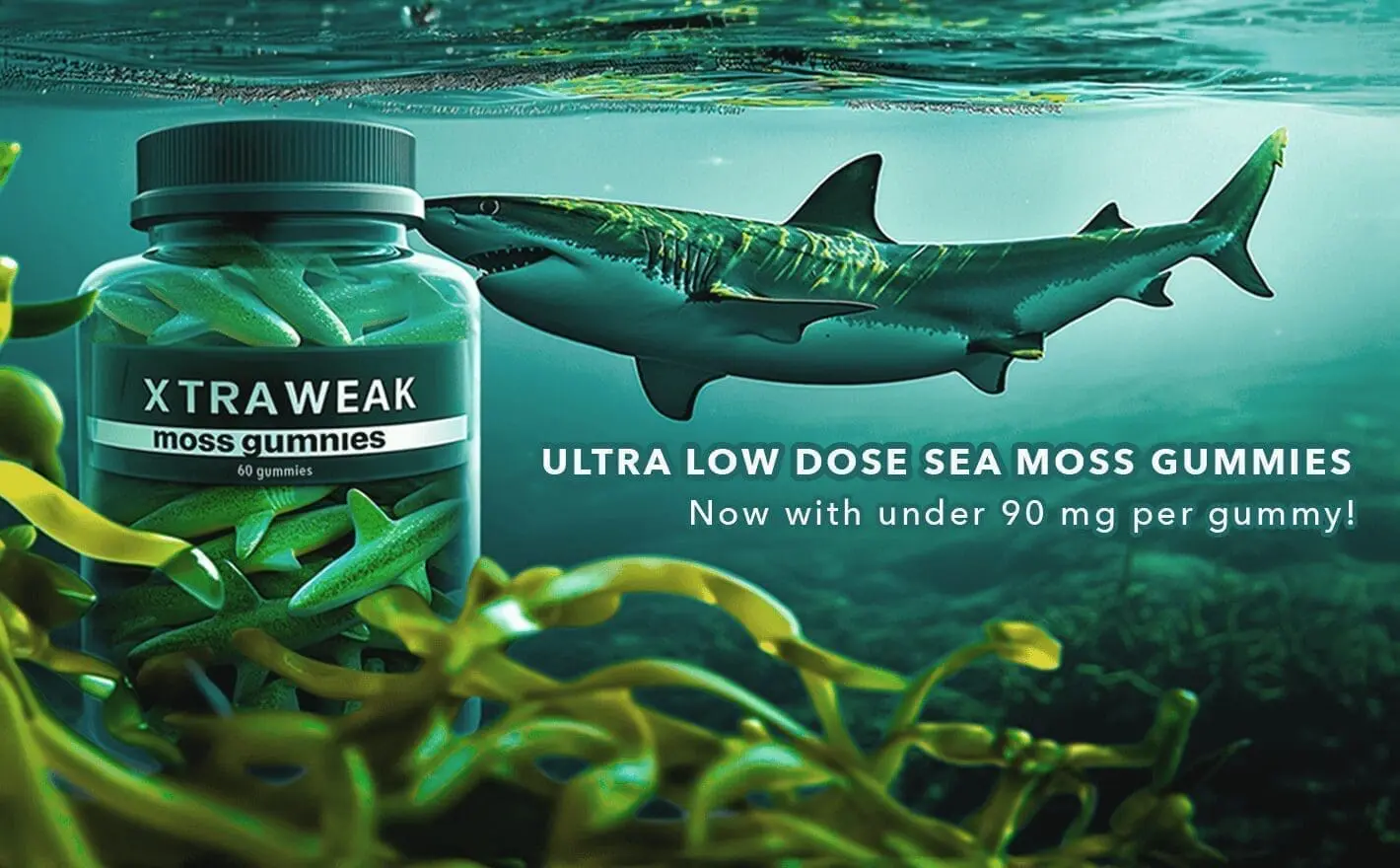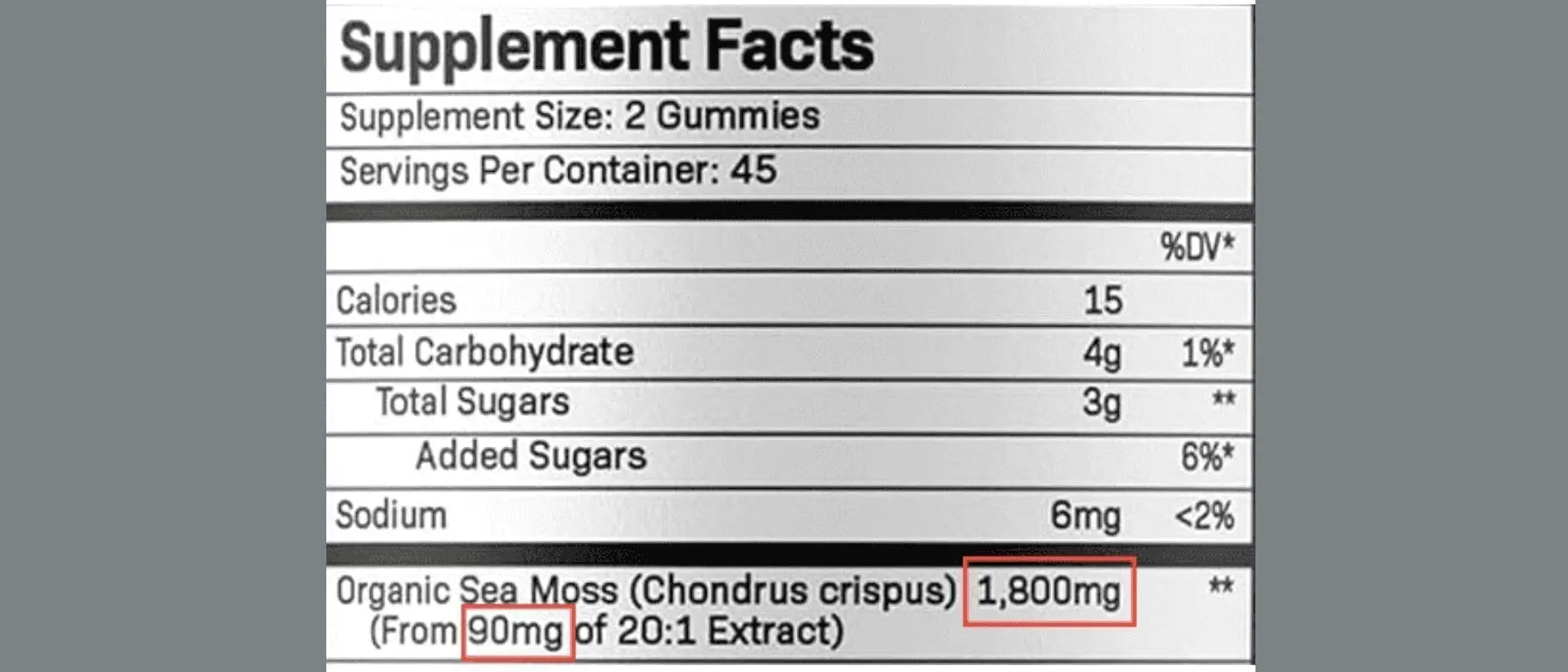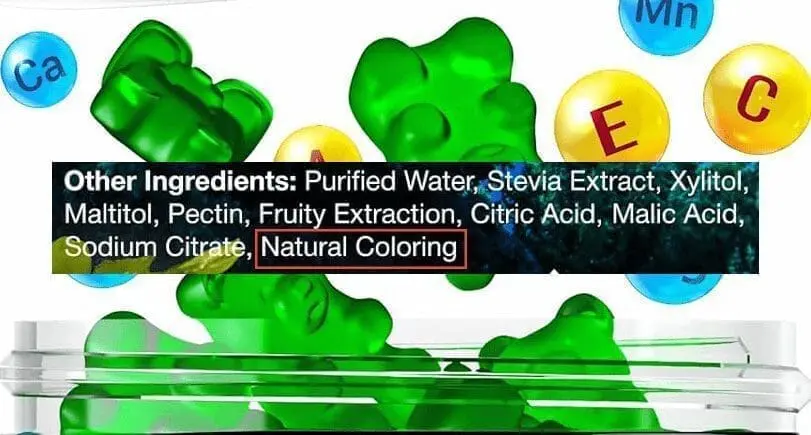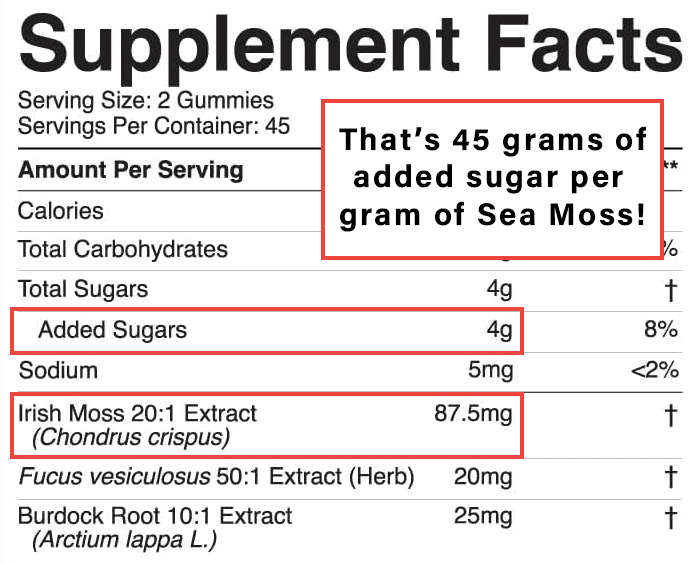In order to help you answer these questions in the most thorough possible, we performed an exhaustive review of 70 different Sea Moss (AKA Irish Sea Moss) gummies. Just like we did in our review of 50 different Shilajit gummies, we pulled out all the stops by painstakingly entering all the data for each product into a huge spreadsheet, then crunching the numbers and finding patterns.
Gummies are an alluring alternative to capsules and powders. After all, it’s more fun to consume something with a pleasant flavor and texture. But are they worth the money?
The stark reality is that Sea Moss gummies will often give you lower quality moss at lower doses for more money, along with added sugar and other ingredients you don’t need. Only 34% were organic, many were extremely under-dosed, and over 80% of them had major transparency issues with their labels or product pages.
Because of the extremely high prevalence of transparency and dosing problems with these products, you’ll want to really scrutinize the label before you buy. Once you read this article, you’ll know what to look out for if you don’t want to get ripped off.
Here’s a breakdown of our findings, with links to each section:
- The price per gram of Sea Moss varied by an incredible 11,400% (from 17 cents all the way up to $19.44 per gram)
- 43% of Sea Moss gummies violated labeling regulations by inflating the amount of Sea Moss they contain (often by 10-20x)
- Over 40% did not properly disclose the coloring agents they used
- 86% had one or more major labeling issues, most of which were related to transparency
- A third of products contained 20 or more grams of sugar per gram of Sea Moss (because many have under 150 mg per serving)
Sea Moss gummy pricing analysis: fewer benefits for more money
Many supplement manufacturers purposely make their labels as confusing as possible in order to make them harder to evaluate for the average shopper. In order to understand the true value of a product, you’ve got to study the label extremely carefully.
As we’ll address in the next section, nearly half of Sea Moss gummy brands inflate their doses by somewhere between 1,000 and 2,000%.
Thus, when you look at a gummy that’s only $12 for a 30 day supply, and it appears to give you a solid dose like 2 grams, it seems like you’re getting a good deal…but when you read the fine print, you’ll realize that you’re actually getting less than 100 milligrams per serving.
After putting all of the real doses into our spreadsheet and running the numbers, we arrived at the shocking conclusion that the prices (in terms of dollars per gram of Sea Moss) varied by a whopping 11,400%!
On the very low end, some products only charged 17 cents per gram of Sea Moss, while others charged as much as $19.44 per gram. How could this be?
It’s because of the lengths that many companies go to in order hide the fact that their Sea Moss gummies only have tiny amounts…

‘Doseflation’: nearly half of Sea Moss gummies are lying about how much Sea Moss they contain
If you want to shop for supplements like a pro, then you need to know about this all-too-common tactic. One of the oldest tricks in the book, it’s something we like to call ‘doseflation’.
Here’s an example from a real Sea Moss gummy label:

It looks like you’re getting 1,800 mg when in fact you’re only getting 90 mg. But it says it’s a 20:1 extract, so isn’t it the same? Not at all. In fact, the concept of an extraction ratio isn’t what most people are led to believe it is.
Our analysis found that 43% (30 out of 70) of Sea Moss gummies used this highly deceptive ‘doseflation’ tactic. This is similar to what we revealed in our analysis of Shilajit gummies, where we found that 38% of them used the same technique.
In reality, ‘20:1 extract’ just means that they started with 20x the amount of plant material that they finished with. It doesn’t mean that the concentration of every nutrient is 20x as much, and in fact that’s almost never the case. In some cases, nutrient density actually decreases in an extract, because extracts will selectively pull certain kinds of compounds out but not others.
Extracts are better suited to herbs like Tongkat Ali rather than mineral-rich superfoods like Sea Moss, which is why CHOQ Irish Moss uses whole plant, organic, wild-crafted Sea Moss (with a real dose of 2,250 mg per serving).
Don’t fall for all the trickery out there in the Wild West of online supplements. Spend some time really scrutinizing the label of any product before you buy it, and you’re less likely to get ripped off.
If you do start reading all these labels, there’s another glaring discrepancy you’re likely to find: many of them have brilliant colors without any reference to an ingredient that would produce those colors…
Over 40% of Sea Moss gummies did not properly disclose their coloring agents
For each of these 70 different products, we read through all of the ‘other ingredients’ to see if we could find ingredients that corresponded to the actual colors of the gummies. We found that an alarmingly high number of them were not properly disclosing how they achieved such brilliant coloration.
For example:

(We superimposed the ‘other ingredients’ over a screenshot of the gummies for easy comparison)
Even if you’re not a professional supplement manufacturer, you can probably tell something’s off here. It would be one thing if they’d listed ‘lemon juice powder’, which would be an acceptable way to explain a lemon flavor.
But, even though lemons are obviously bright yellow, there isn’t any natural ingredient based on lemons that can produce such an intense, dazzling hue.
In all likelihood, this company is using Yellow #5, a chemical that’s been linked to all manner of behavioral issues in children and is banned in some European countries.
Here’s another example:

Needless to say, ‘natural coloring’ is not remotely within the realm of acceptable in terms of how to disclose an ingredient according to the FDA. Regardless of whether your colors are derived from natural or synthetic ingredients, you have to list the specific source.
Mislabeling of ingredients is one of the biggest red flags of all, so if you ever see something as vague as ‘natural coloring’ on a product, don’t buy it.
When it comes to supplements, transparency is EVERYTHING.
CHOQ uses full disclosure labeling, meaning that we never use proprietary blends and always list the exact amount of every active ingredient.
We also disclose every one of our ‘other ingredients’, even those that are in such tiny quantities that we legally don’t have to.

(Some of these more minor issues, like misspelling ingredient names, were almost never the only problem.)
In addition to the problems we discussed in the previous two sections–which were both found in over 40% of Sea Moss gummies–we found that a full 27% (19/70) products failed to even list the ‘other ingredients’ anywhere on the product page.
Many of them simply cropped the label to show everything but the ‘other ingredients’ section, while some of them actually showed what appeared to be the entire back label, but with that section edited out. A handful didn’t even show the back of the label anywhere on the product page.
Considering how many Sea Moss gummies are likely using artificial colors but trying to hide that from you, it’s not surprising that over a quarter of products failed to show their additional ingredients anywhere on the product page.
We found a number of incredibly sloppy labels with all sorts of errors, but here’s one of our favorite examples–a product that somehow has more added sugars than total sugars (and the wrong number of calories):

Sugar content of Sea Moss gummies: up to 45 grams of sugar per gram of Sea Moss
According to our analysis, 16% of Sea Moss gummies (11/70) were sugar-free, and the average amount of sugar per serving was 2.6 grams. However, when you calculate the grams of sugar per actual gram of Sea Moss, things look very different.
Here’s an example of one of the products with the most sugar according to this calculation:

You’d have to eat 51 of these gummies to get the same amount as one serving of CHOQ’s Organic, Wild-Crafted Irish Moss
(However we don’t recommend eating over 3 ounces of sugar in one sitting unless you’re actively trying to torture your pancreas)
About a third of the products we looked at (23/70) had somewhere between 20 and 45 grams of sugar per gram of Sea Moss. That’s why you’ve always got to read the fine print. If you really knew you were eating 4 grams of sugar to get less than 100 mg of moss, you’d have never bought that product.
A few other observations on sweeteners:
- Only 3 products listed corn syrup as a sweetener, though over 30% of products listed ingredients that may be corn-based, such as glucose, sucrose, and dextrose
- Because about a quarter of gummies hid the ‘other ingredients’ section, their sweeteners couldn’t be determined (though we occasionally found real label pictures in customer reviews)
- A couple of products used ingredients that contain sugar but still listed zero sugar
It’s important to point out that–due to the stunningly low transparency and labeling standards of so many of these products–it’s hard to trust whether the sugar quantities they’re providing are really accurate.
Among the sugar-free products in our analysis, three of them did not disclose the sweetener. For those that did, stevia and sugar alcohols like xylitol were equally common.
Keep in mind that recent research has shown that xylitol may be bad for cardiovascular health (click here to read our article on that study).
How to buy Sea Moss gummies like a pro
Overall, the cost-to-benefit ratio doesn’t favor Sea Moss gummies. Considering that, plus the sheer number of products with major transparency issues, this category of supplements is quite the minefield.
Regardless of whether you decide to buy CHOQ or another brand, we still recommend you go with Sea Moss capsules. You’ll be getting more moss for your money and avoiding unwanted sugar and various additives you don’t need in your body.
If you still want to try and find the highest quality Sea Moss gummies, though, here’s what we recommend:
- Make sure you read the fine print on the back of the label so you can find the REAL dose (don’t fall for doseflation!)
- Never buy a product that doesn’t disclose all of its ‘additional ingredients’
- Avoid gummies with extremely bright colors. Most of the legit ones are brown, not neon green.
- If you’re getting a sugar-free gummy, go for stevia instead of xylitol (as it may be bad for your heart)
- Try to find a brand that’s not exclusively sold on Amazon (these are typically the lowest quality)
As we alluded to earlier, CHOQ has some of the highest quality and transparency standards you’ll find anywhere in the supplement industry. While most of the Sea Moss gummies we reviewed don’t even meet minimum labeling requirements, CHOQ exceeds them by practicing full-disclosure labeling.
That means that we always tell you exactly how much of every active ingredient you’re getting. It also means that we list every additional ingredient, even if it’s in such a small quantity that, by law, we don’t have to.
Here’s a list of all the things we don’t allow in our products:
- Artificial sweeteners, flavors, dyes, or preservatives
- So-called ‘natural flavors’ (which are filled with synthetic chemicals)
- Genetically Modified Organisms (GMOs) of any kind
- Low-quality vitamins & minerals like folic acid and magnesium oxide
- Trashy excipients like magnesium stearate and croscarmellose
CHOQ Irish Moss is not only organic & wild-crafted, but also purposely sourced from the Atlantic (due to post-Fukushima radiation concerns). It has a full 2,250 mg per serving and is free of all the unnecessary junk that you’ll find in many other products.
The supplement industry is full of bad actors, but we’re always doing our best to educate consumers on how to shop with a keen eye. If you’d like more information on supplement transparency, adaptogens, superfoods, and everything natural health, be sure to sign up for our newsletter at the bottom of the page (and save 15% off any subscription for life).

